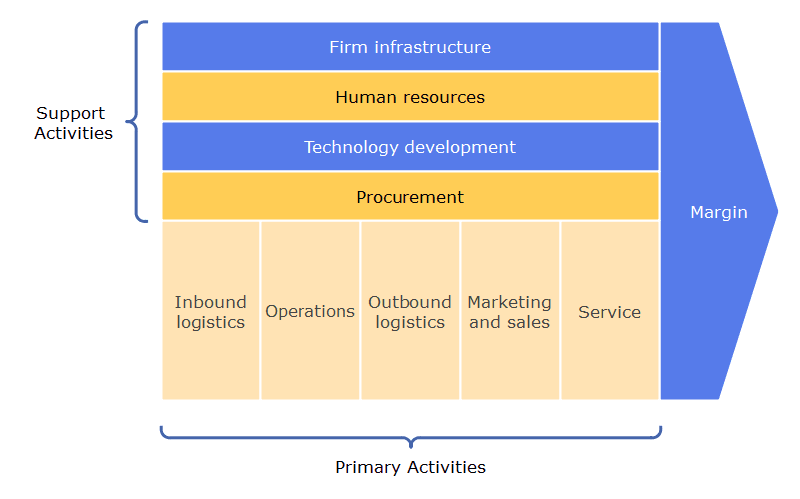Introduction
Service value chain analysis is an excellent visual tool used by service industries and companies to identify the activities that create value for their customers and turns ideas and strategies into reality. Every business or company carries out one of the two economic activities. They either manufacture and sell tangible goods or they develop and provide services. The service industry belongs to the latter category. Value chain analysis helps companies improve activities and processes to increase profitability and reduce production costs by optimizing efforts and turning down resource waste. The service value chain supports businesses like banking, communications, trades, medicines, computer software, and consumer services. Management can improve logistics, sales, and operations with a value chain analysis to add more value to their services. We will discuss the primary and support activities of the service value chain here and learn how PDF Agile makes it easier for you to convert PDF reports.
Background of Service Industry
The service sector is the largest business sector in the modern economy based on the number of employees working in the service industry. The concept of the service industry at the start was a sector that would transport, distribute, and sell goods manufactured by the secondary sector in the three-sector model. Service industries do not manufacture tangible goods like physical products or agriculture. Their 20th-century idea of acting as a supply chain to deliver finished goods to consumers is also evolving. Education, information services, communication, legal services, financial services, and health care are included in the service industry. The service industry is getting bigger and bigger because there are more job opportunities in this sector.

Primary Activities of Service Industry Value Chain Analysis
The service value chain outlines five primary activities essential for a compelling value chain analysis.
Inbound Logistics
Inbound logistics of the service industry is similar to the manufacturing industry, with the only difference in the nature of the product or service. The service value chain lists the primary activities for the distribution and receiving of service inputs. The information on inbound logistics explains how the company sources its processes and how to make the company more successful by optimizing the first activity of the value chain analysis. Service industry logistics includes inseparable services regularly delivered to the consumer via message or email. Intangible services like education or perishable services like assisting work or repair services are also part of the service sector. In the service industry, all services are heterogeneous, meaning they differ from person to person.
Operations
Operations and process management are crucial in a service value chain. Even for the easy supply chain process, like a customer spending a night at a hotel, the employees need to manage the process step-by-step and provide whatever the customer requires, like food, drinks, bedding, and everyday necessities. Another example is the tourism or travelling business that only gives you a great experience as a product. Although it does not seem necessary for the distribution and supply chain in modern economics, the service industry represents many business sectors, including banking, finance, software engineering, and various others.
Outbound Logistics
In the manufacturing industry, outbound logistics is the storing and distributing of finished products to vendors, outlets, or directly to customers. It is the same in the service industry with the slight difference of being faster and no go-between agents. Warehousing of products in a service value chain does not amount to much, but the products customers purchase gives them more value. The service industry also stacks services like products, uploading lots of services online with enough resources that everyone can use without the company running out of stock to increase customer loyalty and create the best value.
Marketing and Sales
Marketing and sales activities in the service value chain are more numerous than the advertisement and selling of goods in the manufacturing industry. In other companies or outlets, people go out and find what they want, and the only problem is that they can’t test it then to make sure the goods they bought are alright. In the service industry, each company, no matter what, have to convince their customers to buy their services, and they do that with marketing and advertising emails, messages, and calls. Various channels, vendors, and sales associates help with marketing and sales.
Services
As the service industry does not deal in physical products, its pre-purchase and post-purchase services differ from the manufacturing industry. The only service these companies provide is the call centers for customer support. Consumers, vendors, and customers call to place orders, discuss the delivery time, and ask quarries about the quality of the service they want to buy. Customers can quickly contact the company and share their queries with the support team to fix any issue, including payment and other issues.
 Support Activities of Service Industry Value Chain Analysis
Support Activities of Service Industry Value Chain Analysis
The value chain analysis for the service industry highlights four crucial support services.
Infrastructure
Efficient management has allowed the service industry to increase its value and provide better-developing strategies, planning, accounting, legal, and quality management. The infrastructure of service industry companies changes for person-to-person because there is a vast area to cover, like hospitality, non-profit, teaching, etc. One type of infrastructure management is enough to carry out many processes and activities in the manufacturing industry because similar companies sell similar physical products.
Human Resource Management
Human resource management is an essential part of the service industry, even with the advancement in technology. The service industry is the only sector with 70 to 80% of employees in the modern economy. These numbers are better than the manufacturing industry because companies use machines and assembly lines to manufacture goods. It takes less time, and no need to train and pay employees. The service value chain is divided into various levels, and human resource management is different for each level.
Technology Development
Technology development brought us fast service platforms where customers can look for the products or services they want, place the order, and get it as quickly as possible. Platforms like Amazon cloud services and BNB played an essential part in the current success and development of the service industry. The technology development for effective services was so innovative that many companies have their startups only focusing on technology development.
Procurement
As we discussed earlier, the nature of any service differs for each sector in the service industry. It is because the world service industry covers a vast market. The procurement activities of the service value chain help companies gain a competitive business advantage. In the BNB model, you only require minimal procurement. On the other hand, sectors like the hospitality and banking industries require many procurements to work properly. Hotels need goods to replace equipment, but they regularly procure supplies to run their business in the banking industry.
Convert PDF Report Using PDF Agile
Converting PDF reports with a PDF editor is easier than going through multiple steps to extract text and some pieces from the PDF report. A PDF document is hard to edit and copy because of its format. Although it takes time to do that, students and professionals still do it because PDF reports are the best way to acquire key information about any topic. PDF Agile is the best PDF editor as it allows you to edit, merge, convert, and compress your PDF documents without wasting time and effort. You can easily convert files from PDF to Word, Excel, PPT, TXT, image, and CAD formats. It comes with many innovative features and an easy-to-use interface similar to Word with the support of multiple formats.
Key Takeaways
The value chain analysis is a visual representation of the primary and support activities with areas of improvement to help companies create the highest value at the least possible cost. We use it to plan each step to create a competitive advantage strategically. Service value chain analysis is the best example of how you can make your service business more profitable and successful using the correct value chain strategies. PDF Agile is the best PDF editor and convertor, with many creative tools for editing, converting, and compressing your PDF document. It supports multiple formats and comes with an easy-to-use interface.
References
- LinkedIn “Porter’s Value Chain - Does it serves the service industry”: From https://www.linkedin.com/pulse/porters-value-chain-does-serve-service-industry-rajesh-bhadwal.
- Pipedrive “Value Chain Analysis Example”: From https://www.pipedrive.com/en/blog/value-chain-analysis





